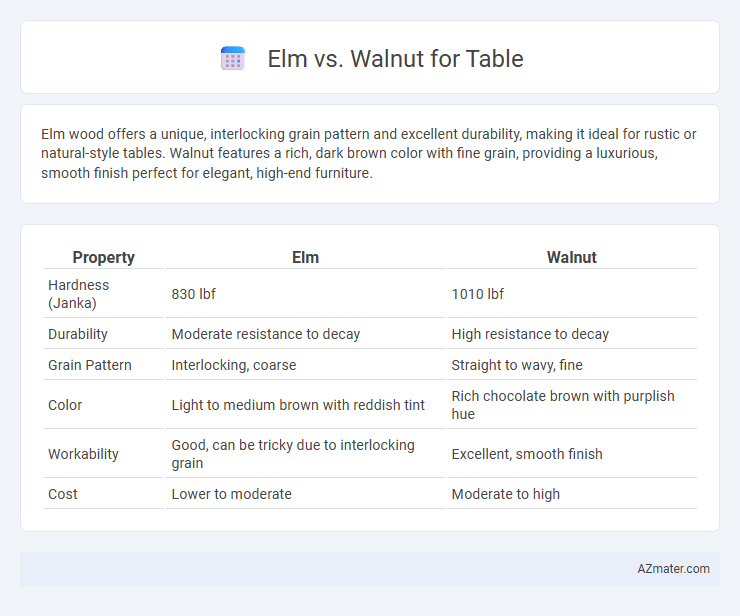Elm wood offers a unique, interlocking grain pattern and excellent durability, making it ideal for rustic or natural-style tables. Walnut features a rich, dark brown color with fine grain, providing a luxurious, smooth finish perfect for elegant, high-end furniture.
Table of Comparison
| Property | Elm | Walnut |
|---|---|---|
| Hardness (Janka) | 830 lbf | 1010 lbf |
| Durability | Moderate resistance to decay | High resistance to decay |
| Grain Pattern | Interlocking, coarse | Straight to wavy, fine |
| Color | Light to medium brown with reddish tint | Rich chocolate brown with purplish hue |
| Workability | Good, can be tricky due to interlocking grain | Excellent, smooth finish |
| Cost | Lower to moderate | Moderate to high |
Introduction to Elm and Walnut Wood
Elm wood features a beautiful grain pattern with excellent durability and natural resistance to splitting, making it ideal for crafting sturdy tables. Walnut wood is prized for its rich, dark color and smooth texture, offering both strength and an elegant finish suitable for high-end furniture. Both elm and walnut provide unique aesthetic and structural qualities that influence the choice of wood for table construction.
Botanical Origins and Growth Regions
Elm wood, derived from trees in the genus Ulmus, primarily grows across temperate regions of North America, Europe, and Asia, thriving in moist, well-drained soils often near rivers. Walnut wood, sourced from the Juglans genus, is predominantly found in North America and parts of Europe, with the black walnut (Juglans nigra) being highly prized for table-making due to its dense, fine-grained structure. The different growth environments influence each wood's hardness and grain patterns, with elm typically exhibiting interlocking grain for added strength, while walnut offers rich color variations and a smooth finish.
Grain Patterns and Color Differences
Elm wood features interlocking grain patterns with a coarse, wavy texture that enhances table surfaces with unique visual interest, while Walnut exhibits straight, finer grains providing a smooth, elegant appearance. Elm tends to display varied shades of golden to reddish-brown hues with occasional darker streaks, contrasting with Walnut's rich, deep chocolate brown to purplish-black tones that darken over time. The distinct grain complexity of Elm adds rustic charm, whereas Walnut's consistent coloration offers sophisticated warmth, influencing the aesthetic choice for table designs.
Strength and Durability Comparison
Elm wood offers robust interlocking grain patterns that provide excellent resistance to splitting and warping, making it highly durable for table construction. Walnut, known for its hardness and dense cellular structure, delivers superior resistance to dents and scratches, contributing to long-term strength and durability. While elm excels in impact resistance and flexibility, walnut outperforms in hardness and compression strength, making both woods suitable for durable tables depending on specific use conditions.
Workability for Crafting Tables
Elm wood offers excellent workability for crafting tables due to its moderate hardness and fine, interlocked grain, allowing smooth cutting and shaping while reducing splitting risk. Walnut provides superior workability with its fine, straight grain and natural oils, making it easy to plane, carve, and finish to a high standard. Both woods respond well to various tools and finishes, but walnut's stability and rich color often make it a preferred choice for premium table craftsmanship.
Finish and Maintenance Requirements
Elm wood features a distinctive grain and a warm, rich finish that highlights its natural beauty but typically requires regular oiling or waxing to maintain its luster and protect against moisture. Walnut offers a smooth, dark finish that ages gracefully with natural patina and demands less frequent maintenance, often only needing periodic cleaning and occasional refinishing to preserve its elegant appearance. Both woods benefit from protective coatings to prevent scratches and stains, but walnut's denser grain structure generally makes it more resistant to wear over time.
Cost and Availability
Elm wood is generally more affordable than walnut, making it a cost-effective choice for table construction, especially for budget-conscious buyers. Walnut, prized for its rich color and durability, tends to be more expensive due to limited availability and higher demand in luxury furniture markets. Elm's wider availability in North America and Europe contrasts with walnut's relatively scarce supply, contributing to the price gap between the two woods.
Eco-Friendliness and Sustainability
Elm wood is highly sustainable due to its rapid growth and natural resistance to pests, reducing the need for chemical treatments, making it an eco-friendly choice for tables. Walnut, while slower growing and thus less renewable, offers durability and longevity, which promotes sustainability by extending the life cycle of furniture. Choosing elm supports faster forest regeneration, whereas walnut emphasizes long-term use, both contributing differently to sustainable table production.
Best Uses: When to Choose Elm vs Walnut
Elm wood excels for rustic and outdoor tables due to its interlocking grain that resists splitting and warping, making it ideal for farmhouse or natural-style furniture. Walnut is favored for formal, high-end tables where a rich, dark finish and fine grain detail enhance luxury and elegance. Choose elm for durability and organic textures in casual settings, while walnut suits refined interiors requiring strength combined with a smooth, polished surface.
Conclusion: Picking the Right Wood for Your Table
Elm offers a striking grain pattern and excellent durability, making it ideal for rustic and traditional table designs, while walnut provides a rich, dark color and smooth finish suited for elegant, modern styles. Consider the table's intended use, aesthetic preferences, and budget, as walnut is typically more expensive but offers superior stability and resistance to wear. Choosing between elm and walnut ultimately depends on balancing visual appeal, durability needs, and cost for your specific table project.

Infographic: Elm vs Walnut for Table
 azmater.com
azmater.com